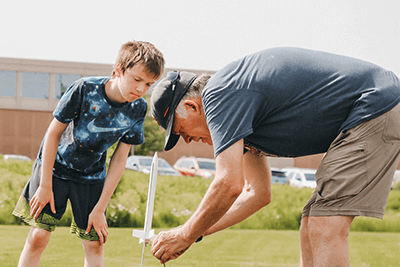September 8, 2022
 from Dr. Bill Hudson, head of school
from Dr. Bill Hudson, head of school
Institutions, like individuals or families, evolve. It is a natural part of life but it can sometimes be challenging and disconcerting. When my legs ached as an eleven-year-old, my father told me to “Walk it off. It’s just growing pains.” This has evolved into my doctor telling me to walk it off, but instead he’s referring to the extra weight I am carrying!
Our society has experienced a great deal of disruption over the last several years. A public health crisis, racial reckoning, political discord, and an uncertain economy coupled with confusion about what is going to happen moment to moment, day to day, week to week, has caused many to feel anxious and stressed. Our amygdala takes over in these times and the prefrontal cortex—the part that learns and plans and creates—isn’t fully engaged. Too much disruption in a short period of time can intensify negative feelings and it is well documented that this has been the case in recent times.
In times of disruption, schools must evolve to meet changing needs. At MPA, this evolution takes shape through a new strategic plan, some new leaders and employees, many new students and families, and some new curricular experiences. These are all good things for an institution because they are opportunities for growth and the results of continuous improvement. As an institution, we have always been committed to growth and improvement—never resting on our laurels—so this is not new or different at MPA.
Many years ago, in my first year as a head of school, a teacher passed along an article that Anne Staveny, head of school at The Blake School, wrote for a national publication known as the Trustee’s Newsletter. As a new head of school, Anne’s thoughtful approach to describing institutional evolution was very helpful to me. Anne has since become a good friend and colleague and gave me permission to share it with you.
- A high-functioning school continuously evolves. Our students will graduate into a world that demands different skills than did the world their grandparents, parents and older siblings inherited. Preparing graduates for our rapidly changing world is the core and cause of evolving curriculum.
- When contemplating a change, we are almost always considering a trade-off between competing “goods.” We are rarely in a clear position of choosing between an ineffectual practice and a successful one. Most often, we must consider a promising proposal against an existing beneficial program. Good things would come of both, but we must evaluate the benefits of each against the other.
- We must consider institutional change in context. What was once an effective strategy may have outlived its usefulness or may have been outstripped by new knowledge. In proposing change, we do not denounce past practices. Rather, we simply identify the next stage in a school’s evolution. For example, new technologies permit us to teach differently, and we should benefit from such technologies when we can.
- A great school seeks to instantiate its core values and live out its mission in every dimension of the organization. An effective school leader tries to identify misalignments between core values and practices that fail to promote those values. Effective leadership also calls for creating new alignments to meet strategic goals.
- To manage change, leaders must garner participation without sinking into paralysis. Diverse voices ensure sound thinking and shared investment in the outcome. We must also manage concerns about process that threaten to overtake the conversation and impede larger goals.
- Perfection can be the enemy of progress. We should not expect the first iteration of a program or practice to be perfect. Rather, we should expect to learn from “good mistakes,” decisions based on sound information that do not go as expected. We must improve on our work with each iteration.
Change is not only a constant; it’s also what fuels our work. Education is fundamentally a hopeful enterprise—one founded on the belief that humans have the capacity for change. At their most successful, schools change students every single day by developing in them new skills, by deepening their knowledge, and by enlarging their understanding of themselves, of each other, and of the world.
Many years ago, I learned a cardinal rule: “First different, then better. Most people want things to be better but not different.” If you ever have questions, I encourage you to reach out to a teacher or administrator. Our commitment to partnering with parents is built upon a sincere desire for transparency, a deep sense of trust, and profound respect for all community members—these things carry us through disruption and evolution. Please know that our commitment to MPA’s mission and values will always remain at the heart of all we do.